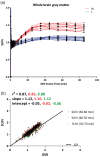Quantification of [18F]florbetapir: A test-retest tracer kinetic modelling study
- PMID: 29897009
- PMCID: PMC6826855
- DOI: 10.1177/0271678X18783628
Quantification of [18F]florbetapir: A test-retest tracer kinetic modelling study
Abstract
Accumulation of amyloid beta can be visualized using [18F]florbetapir positron emission tomography. The aim of this study was to identify the optimal model for quantifying [18F]florbetapir uptake and to assess test-retest reliability of corresponding outcome measures. Eight Alzheimer's disease patients (age: 67 ± 6 years, Mini-Mental State Examination (MMSE): 23 ± 3) and eight controls (age: 63 ± 4 years, MMSE: 30 ± 0) were included. Ninety-minute dynamic positron emission tomography scans, together with arterial blood sampling, were acquired immediately following a bolus injection of 294 ± 32 MBq [18F]florbetapir. Several plasma input models and the simplified reference tissue model (SRTM) were evaluated. The Akaike information criterion was used to identify the preferred kinetic model. Compared to controls, Alzheimer's disease patients had lower MMSE scores and evidence for cortical Aβ pathology. A reversible two-tissue compartment model with fitted blood volume fraction (2T4k_VB) was the preferred model for describing [18F]florbetapir kinetics. SRTM-derived non-displaceable binding potential (BPND) correlated well (r2 = 0.83, slope = 0.86) with plasma input-derived distribution volume ratio. Test-retest reliability for plasma input-derived distribution volume ratio, SRTM-derived BPND and SUVr(50-70) were r = 0.88, r = 0.91 and r = 0.86, respectively. In vivo kinetics of [18F]florbetapir could best be described by a reversible two-tissue compartmental model and [18F]florbetapir BPND can be reliably estimated using an SRTM.
Keywords: Alzheimer’s disease; Amyloid positron emission tomography; [18F]florbetapir; test–retest; tracer kinetic modelling.
Figures





References
-
- Dubois B, Feldman HH, Jacova C, et al. Research criteria for the diagnosis of Alzheimer’s disease: revising the NINCDS-ADRDA criteria. Lancet Neurol 2007; 6: 734–746. - PubMed
Publication types
MeSH terms
Substances
LinkOut - more resources
Full Text Sources
Other Literature Sources
Medical

